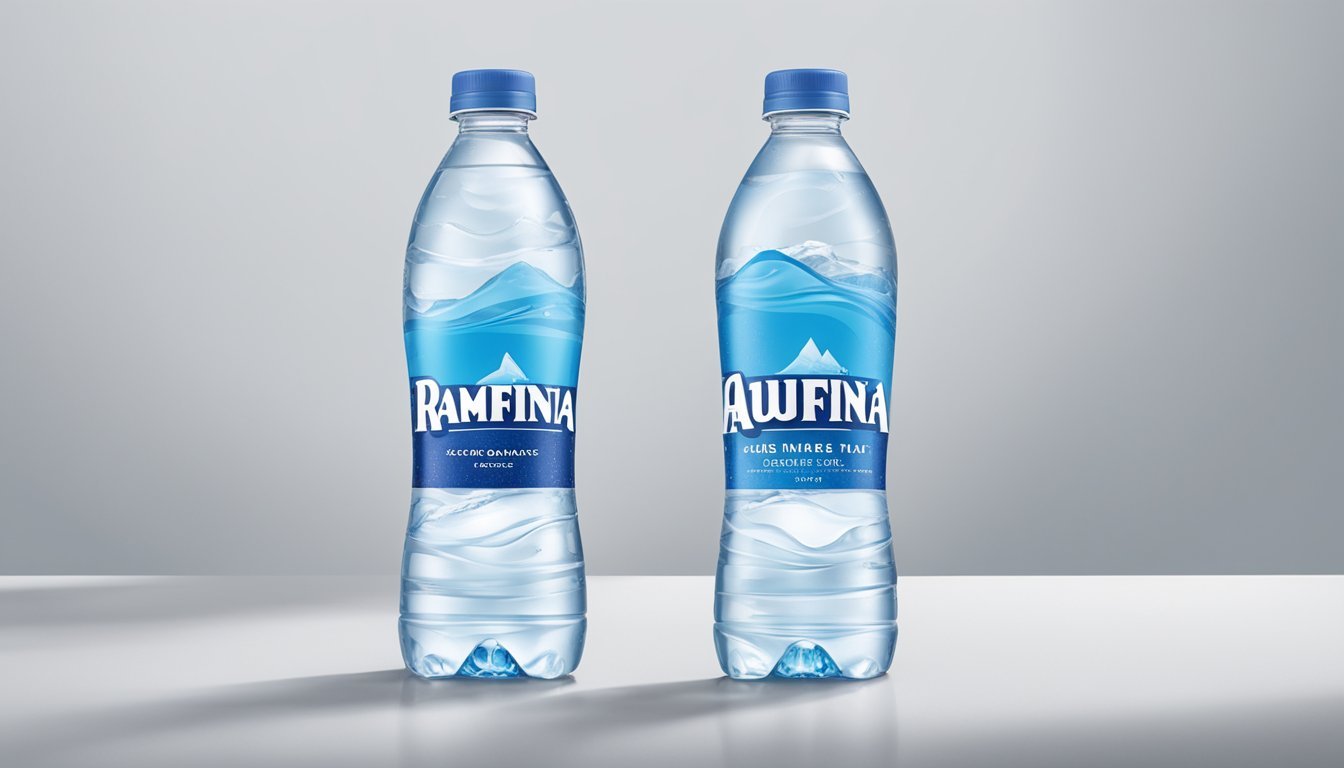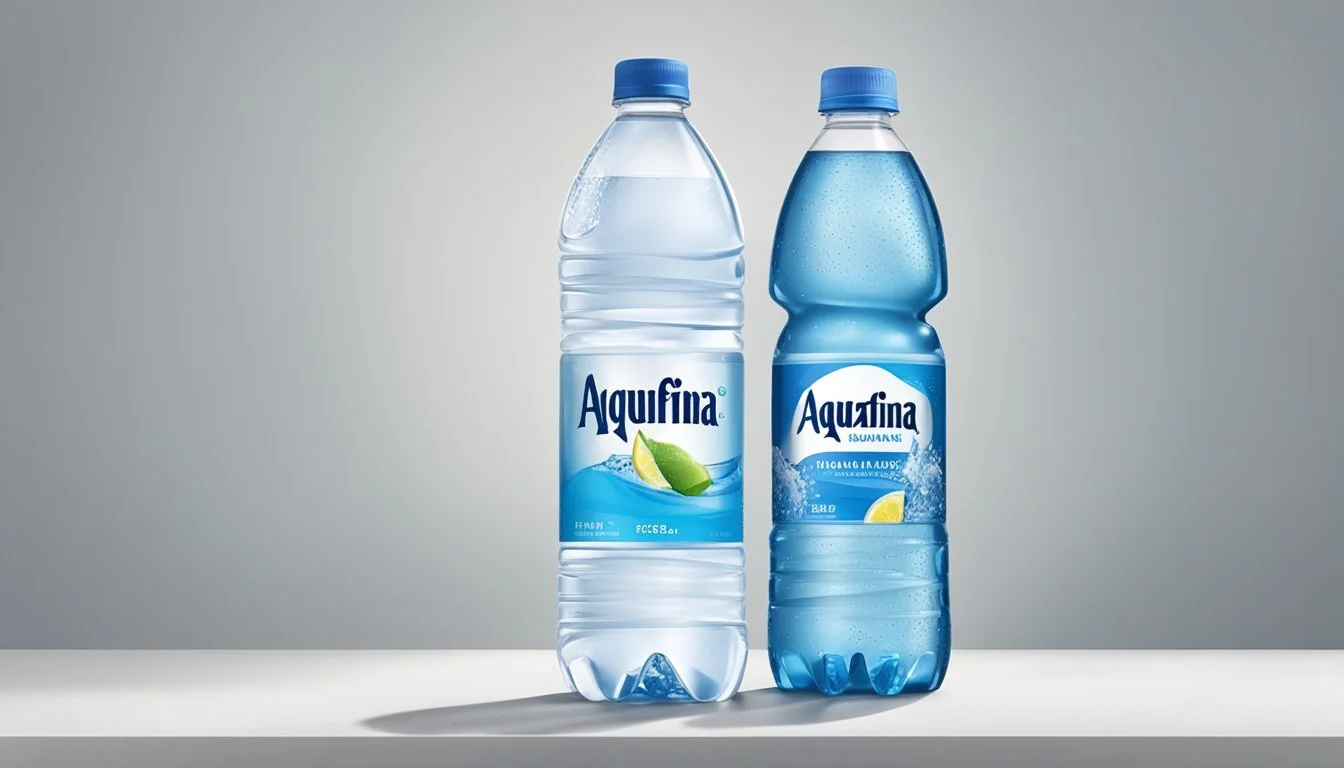Aquafina vs. Ramona
Comparative Analysis of Bottled Water Quality
When choosing between Aquafina and Ramona bottled water, consumers often weigh various factors such as taste, purity, and sourcing. Aquafina, produced by PepsiCo, is known for its rigorous purification process that includes reverse osmosis and ozonation, ensuring a clean and consistent taste. On the other hand, Ramona, though lesser-known, prides itself on its natural spring water sourcing, offering a different profile that appeals to purists.
If you value a meticulously purified, reliably neutral-tasting water, Aquafina stands out as the better option. However, for those who prefer the crisp, distinct taste of naturally sourced spring water, Ramona offers a compelling alternative.
Readers will find an in-depth comparison of these two brands in subsequent sections, evaluating them on multiple criteria to help make an informed decision. Whether prioritizing taste or purity, the upcoming analysis aims to provide clarity in the often saturated bottled water market.
Understanding Bottled Water
Bottled water comes in various forms, each with particular characteristics and benefits. It is critical to consider its types, health impacts, environmental footprint, and regulatory standards.
Types of Bottled Water
Bottled water includes several types, primarily spring water, purified water, and mineral water.
Spring Water: Sourced from natural springs, known for its natural mineral content.
Purified Water: Undergoes extensive processing like reverse osmosis to remove impurities. Popular brands include Aquafina.
Mineral Water: Contains minerals naturally or added during bottling, often marketed for their health benefits. Understanding the differences between these types helps consumers make informed choices based on preferences and needs.
Health and Hydration
Hydration is essential for overall health, and bottled water can be a convenient source.
Purified Water: Generally low in contaminants, appealing to those seeking clean hydration.
Mineral Water: Offers additional minerals like calcium and magnesium, promoting bone and heart health.
Alkaline Water: Marketed for balancing body pH levels, though scientific evidence is mixed. Not all bottled waters offer the same level of hydration benefits, as some might have added substances affecting taste and purity.
Environmental Considerations
The environmental impact of bottled water is significant.
Plastic Waste: Single-use plastic bottles contribute massively to pollution. Recycling rates are low.
Carbon Footprint: Production and transportation of bottled water have a substantial carbon footprint.
Alternative Packaging: Some brands are moving towards eco-friendly packaging, but adoption is slow. Consumers need to weigh the convenience of bottled water against its environmental drawbacks and consider sustainable options.
Regulatory Standards
Bottled water is subject to stringent regulatory standards to ensure safety and quality.
FDA: Regulates bottled water as a food product in the U.S., ensuring that it meets safety standards.
EPA: Oversees public water systems, but bottled water is often compared to these standards for quality assurance.
Labeling Requirements: Companies must disclose sources and treatment methods to inform consumers. Understanding these standards helps consumers trust the safety and quality of their bottled water choices.
Aquafina and Its Manufacturing Process
Aquafina’s manufacturing process is well-regarded for its meticulous purification stages and the strategic addition of minerals and electrolytes to enhance flavor. As a part of PepsiCo, Aquafina benefits from a robust quality control system.
Purification Techniques
Aquafina employs the HydRO-7 filtration process. This is a seven-step purification system designed to remove impurities and contaminants often missed by other methods.
Stages include:
Reverse Osmosis
Carbon Filtration
UV Disinfection
These stages collectively ensure the water's purity. This extensive method results in water that is exceedingly pure, limiting potential contaminants that could affect taste and safety.
The Role of Minerals and Electrolytes
While the water is thoroughly purified, minerals and electrolytes are reintroduced to enhance taste.
Common additives include:
Magnesium sulfate
Potassium chloride
Sodium chloride
These minerals not only improve flavor but can also offer slight hydration benefits, making Aquafina a preferred choice for both taste and health reasons.
Aquafina and PepsiCo
Aquafina is a flagship brand under PepsiCo, one of the largest beverage companies globally. Being part of PepsiCo ensures stringent quality controls and consistent product standards.
PepsiCo's contributions:
Advanced manufacturing facilities
Comprehensive quality assurance programs
This relationship provides Aquafina with significant resources and expertise, ensuring a reliable product for consumers around the world.
Evaluating Water Quality
When evaluating the quality of bottled water, key factors include taste profiles, assessment of purity, and pH levels and acidity. Each of these factors is crucial in determining the overall quality of the water you consume.
Taste Profiles
Taste is often one of the first considerations for consumers choosing between Aquafina and Ramona. Aquafina is known for its 7-step HydRO-7 filtration process which aims to remove impurities and deliver a clean, crisp taste.
Ramona, although lesser-known, prides itself on purity and natural mineral content, giving it a distinct taste profile.
Some consumers report a slight tang in Aquafina, which might be off-putting for some, whereas Ramona’s taste is usually described as fresher and more balanced due to natural mineral content. Mineral salts added to water can greatly impact taste, lending to some preferences over others.
Assessment of Purity
Aquafina utilizes a multi-step purification process termed HydRO-7, which is designed to reduce substances that other bottled waters may leave behind.
This process includes microfiltration, reverse osmosis, and ultraviolet light disinfection. This rigorous method ensures that the water is nearly free of dissolved solids, making it quite pure.
Ramona, on the other hand, emphasizes natural purity. It sources its water from protected natural springs and subjects it to minimal processing to maintain its original state. This approach not only preserves natural minerals but also ensures the water remains as close to its natural form as possible.
PH Levels and Acidity
The pH level of water can influence both its taste and its impact on the body. Aquafina tends to have a slightly acidic pH, generally around 5.5 to 7, making it neutral to slightly acidic.
Ramona usually boasts a more alkaline pH, often ranging from 7.5 to 8.5, which some consumers believe contributes to better hydration and a more refreshing experience.
Higher alkalinity in water like Ramona’s can neutralize acidity in the body, while the near-neutral pH of Aquafina ensures it remains non-aggressive and easy on the digestive system. Monitoring pH is crucial as it can affect everything from enzyme activity in the body to basic hydration effectiveness.
Branding and Consumer Choices
Aquafina and Ramona possess distinctive branding and marketing strategies that cater to different consumer needs. These strategies influence packaging, pricing, and overall market presence.
Comparing Brand Narratives
Aquafina, owned by PepsiCo, emphasizes purity and a rigorous purification process known as Hydro-7, which includes steps like reverse osmosis and UV treatment. This underscores a message of high quality and safety.
Ramona positions itself as a lifestyle brand, often appealing to eco-conscious consumers. Its marketing highlights its commitment to sustainable practices and also tends to target young, trend-focused demographics.
Packaging and Convenience
Aquafina's packaging typically features a sleek, clear plastic bottle with a blue label. This design is conventional yet recognizable, catering to consumers seeking reliable and straightforward bottled water options.
Ramona's packaging, by contrast, often uses eco-friendly materials like recycled plastics. The bottles might have unique designs that stand out on shelves, attracting environmentally aware and design-oriented buyers.
Market and Price Analysis
Aquafina is competitively priced and widely available in various retail outlets, making it a convenient choice for many. Its market position as a staple, reliable bottled water places it in direct competition with other major brands.
Ramona, while potentially more expensive, offers the added value of sustainability and aesthetic appeal. Its market target is smaller but more niche, focusing on consumers willing to pay a premium for environmentally friendly products.
Brand Cost Packaging Market Focus Aquafina Moderate Clear Plastic Bottle Mass Market Ramona Higher Eco-friendly, Stylish Niche Market
By understanding these facets, consumers can make informed choices based on brand narrative, packaging, and market positioning.
Competitors in the Bottled Water Industry
The bottled water market is diverse, featuring a range of brands that compete fiercely for consumer preference. Some stand out for their filtration processes, mineral content, or eco-conscious efforts.
Dasani: A Close Examination
Dasani, owned by Coca-Cola, employs reverse osmosis filtration to purify its water. After purification, minerals such as magnesium sulfate, potassium chloride, and salt are added to improve taste.
Key Features:
Filtration: Reverse Osmosis
Additives: Minerals for taste
Reputation: Widely available and affordable
Despite its widespread availability, Dasani has received mixed reviews regarding its taste, largely due to the added minerals. Its strong brand presence makes it a significant competitor in the bottled water industry.
Premium Brands: Voss, Fiji, and Evian
Premium bottled water brands like Voss, Fiji, and Evian offer distinct profiles that cater to consumers seeking high-quality and naturally sourced water.
Voss:
Source: Artesian wells in Norway
Packaging: Known for its sleek, glass bottles
Market Position: Luxury brand
Fiji:
Source: Artesian aquifer in Fiji
Mineral Content: Naturally occurring silica, electrolytes
Market Position: Premium quality, marketed for its natural purity
Evian:
Source: French Alps spring
Mineral Content: Balanced mineral composition
Market Position: Long-standing reputation for quality and purity
These brands are often viewed as status symbols, appealing to consumers willing to pay a premium for perceived quality and unique sourcing.
Eco-Conscious Options: Boxed Water and Lifewtr
As environmental concerns grow, eco-friendly alternatives like Boxed Water and Lifewtr are gaining traction.
Boxed Water:
Packaging: 92% plant-based cartons
Sustainability: Focus on reducing plastic waste
Market Position: Eco-friendly choice
Lifewtr:
Packaging: Made with 100% recycled plastic
Philanthropy: Supports artists through customized label designs
Market Position: Artistic and environmental initiative
These brands highlight their environmental efforts, attracting consumers who prioritize sustainability. By addressing issues such as plastic pollution and supporting recycling initiatives, they offer a compelling alternative to traditional bottled water.
Health and Gold Standard Bottled Waters
Understanding the health benefits, the role of minerals and electrolytes, and how different bottled waters rank can help you make an informed choice between Aquafina and Ramona.
Minerals, Electrolytes, and Health Benefits
Minerals and electrolytes are critical for health. Aquafina and Ramona offer unique profiles.
Aquafina, a purified water, often contains added minerals for taste, though they are minimal compared to spring or mineral waters. Ramona, sourced from natural springs, generally offers a richer mineral profile which can include calcium, magnesium, and potassium. These can help in maintaining bone health and proper muscle function.
For those prioritizing hydration and replenishment after physical activities, choosing water with a higher electrolyte content, typically found in spring or mineral waters like Ramona, might be more beneficial.
Antioxidants and Alkaline Water
Antioxidants are critical for reducing oxidative stress in the body. While standard bottled waters, including Aquafina and Ramona, do not typically offer antioxidant properties, there are specialized waters on the market known for this feature.
Alkaline water, which has a higher pH, is another health trend. Ramona’s natural spring sourcing might naturally align closer to an alkaline state than Aquafina, which is more neutral due to its purification process. Some believe alkaline water can help balance the body's pH levels, though more research is needed.
Bottled Water Rankings: Best and Worst
When ranking bottled waters, taste, source, and health benefits are essential.
Aquafina generally ranks high for its wide availability and consistent taste, thanks to extensive purification. However, its minimal mineral content puts it lower in health-centric rankings. Ramona, with a more robust mineral profile from its spring source, might rank higher for health benefits but could vary in availability and taste consistency.
Sources like TODAY and Illuminate Labs often list popular brands, considering factors such as pH balance, purity, and cost.
Evaluating these aspects helps consumers decide their best bottled water choice, whether prioritizing health, taste, or environmental impact.
Sources and Sustainability
When exploring Aquafina and Ramona, it is essential to consider their water sources, sustainability practices, and environmental impacts since these factors heavily influence consumer choices and the planet.
Natural Sources: Springs and Groundwater
Aquafina sources its water from public water supplies, which undergoes a rigorous purification process. This HydRO-7 filtration ensures the removal of most impurities, providing clean and safe drinking water. Unlike natural spring water, Aquafina’s treatment transforms regular tap water into a pure product.
Ramona, on the other hand, emphasizes natural sources such as springs and groundwater. This water is often considered more pristine due to its origin in natural springs. The minimal processing involved retains natural minerals. This focus on sourcing from natural environments may appeal to those seeking water directly from the earth, without extensive treatment.
The Bottling Process and Sustainability
Aquafina uses plastic bottles made from PET, which are lightweight and recyclable. However, the environmental impact of plastic remains a significant concern. Recently, they have pushed for more environmentally friendly packaging, including bottles with reduced BPA content and increased recycling initiatives.
Ramona also packages its products considering sustainability. Many of their bottles are made from glass or BPA-free plastic. Glass is fully recyclable and does not leach chemicals, making it a sustainable option. The bottling process for Ramona prioritizes minimizing environmental impact through the use of eco-friendly materials and reduced transportation costs due to local sourcing.
Consumer Impact and Environmental Footprint
The choice between Aquafina and Ramona can significantly affect the environment. Consumer impact stems from both the source and the bottling method. Aquafina’s extensive filtration of municipal water means less use of natural spring sources, but higher energy consumption due to purification.
Ramona’s use of natural spring water requires minimal processing, thus reducing energy consumption. However, transportation costs and fuel use might rise if sourced from remote springs. It's critical to consider both the packaging materials and the origin of water to fully grasp the environmental footprint.
For consumers, choosing a more sustainable option involves understanding the balance between purified municipal sources and minimally processed spring water. Each has implications for sustainability and overall environmental impact.
Closing Remarks
When comparing Aquafina and Ramona, a few crucial factors come to light. Aquafina, widely known for its rigorous purification process, goes through the HydRO-7 method. This process is designed to remove more substances than typical bottled waters.
Ramona offers a different experience. It strives to maintain a naturally refreshing taste by sourcing its water from pristine springs. This often appeals to those looking for a more unprocessed option.
Purification Process
Aquafina: HydRO-7 filtration
Ramona: Natural spring sourcing
Taste Profile
Aquafina: Clean and consistent
Ramona: Natural and refreshing
Mineral Content
Aquafina: Limited mineral additives for taste
Ramona: Naturally occurring minerals
Packaging Options
Aquafina: Available in multiple sizes, including eco-friendly options
Ramona: Typically found in standard bottle sizes
Each brand brings something distinct to the table. Aquafina focuses on purity and consistency, appealing to individuals who prioritize a standardized taste. Ramona, on the other hand, emphasizes a natural experience, offering water that reflects its spring origins.
Both brands have their strengths, and the choice ultimately depends on what you value more in bottled water. Whether it’s the rigorous filtration of Aquafina or the natural freshness of Ramona, there’s a quality option for everyone.







